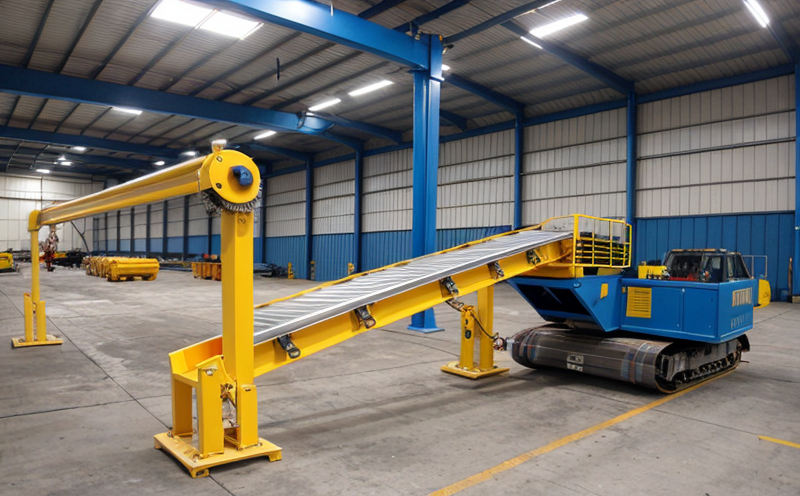ISO 15236 Conveyor Belt Steel Cord Strength Testing
The ISO 15236 standard provides a method to determine the tensile strength of steel cords used in conveyor belts. This testing is critical for ensuring that the conveyor belt can withstand the high loads and stresses encountered during operation. In mines, where heavy materials are frequently transported over long distances, conveyor belts play an essential role in the efficiency and safety of operations.
The process involves cutting a sample from the conveyor belt and subjecting it to tension until failure occurs. The maximum load at which the steel cord fails is recorded as the tensile strength. This measurement helps to predict the lifespan and reliability of the conveyor belt under real-world conditions.
Testing according to ISO 15236 ensures that mining equipment adheres to international standards, enhancing safety and performance in a sector where heavy loads are handled daily. The test results can be used by quality managers to make informed decisions about procurement and maintenance schedules. Compliance officers rely on these tests as part of their due diligence processes to ensure regulatory adherence.
R&D engineers use this data to improve the design and durability of conveyor belts, while procurement teams can leverage it to source materials from reliable suppliers who meet stringent quality standards.
Understanding the testing procedure is crucial for those in the mining industry. The steel cords are cut to a specific length and width before being mounted on a tensile testing machine. The machine applies controlled tension until failure occurs, recording both the maximum load and the elongation at that point. This data is then analyzed to ensure compliance with ISO 15236.
The test setup requires precise alignment of the steel cord sample within the grips of the tensile testing machine. The machine must be capable of applying incremental loads in a controlled manner, ensuring accurate readings. Calibration and validation are key steps before each series of tests to ensure consistent results.
For mining applications, the results of ISO 15236 testing can significantly impact safety protocols. By understanding the tensile strength of the steel cords, mine operators can better anticipate potential failures and plan for maintenance or replacement. This foresight helps prevent costly downtime and ensures continuous operations.
The importance of this test cannot be overstated in a sector where equipment failure could lead to significant operational disruptions. The reliability of conveyor belts directly impacts the efficiency of mining processes, making ISO 15236 testing an indispensable part of quality assurance programs.
Compliance with international standards like ISO 15236 is essential for maintaining high safety and performance levels in mining operations. By adhering to these guidelines, mines can ensure that their conveyor belts are robust enough to handle the demands placed on them daily.
Quality and Reliability Assurance
- Consistent Testing: Ensuring every sample is tested under controlled conditions for accurate results.
- Data Integrity: Maintaining a robust database of test results to track trends and identify potential issues early.
- Safety Protocols: Implementing stringent safety measures during testing to prevent accidents and injuries.
- Regular Calibration: Keeping all testing equipment in optimal working condition through regular calibration checks.
- Training Programs: Providing ongoing training for personnel involved in the testing process to ensure they are up-to-date with best practices and new technologies.
The rigorous adherence to these quality assurance measures guarantees that every conveyor belt undergoing ISO 15236 testing meets the highest standards of reliability and safety. This approach not only enhances operational efficiency but also contributes significantly to worker safety in one of the most hazardous industries globally.
Customer Impact and Satisfaction
By ensuring that all conveyor belts meet or exceed ISO 15236 standards, our testing service directly impacts customer satisfaction. Mines and other industrial facilities can operate their equipment with greater confidence knowing that the steel cords used are capable of withstanding the extreme conditions they face daily.
This reliability translates into reduced downtime, lower maintenance costs, and improved overall performance of mining operations. Customers benefit from safer working environments as well, which is a critical factor in maintaining high levels of worker satisfaction.
Our commitment to quality and reliability through ISO 15236 testing aligns with the broader goals of our customers. By providing consistent, accurate test results, we help them make informed decisions about their procurement processes and equipment maintenance schedules. This collaborative approach ensures that both parties achieve their objectives efficiently and effectively.
Moreover, by staying compliant with international standards like ISO 15236, we contribute to the reputation of our customers in the industry. Compliance not only demonstrates a commitment to safety but also showcases a dedication to excellence, which can lead to increased business opportunities and improved relationships with stakeholders.
Environmental and Sustainability Contributions
Incorporating ISO 15236 testing into mining operations supports sustainability efforts by ensuring that conveyor belts are built for longevity. This reduces the frequency of replacements, which in turn decreases waste generation and resource consumption.
By enhancing the durability of conveyor belts, this service also contributes to energy efficiency within mines. Longer-lasting equipment means less frequent downtime, leading to more efficient operations overall. This increased operational efficiency translates into lower fuel consumption and reduced carbon emissions from mining vehicles and machinery.
The testing process itself is conducted in a way that minimizes environmental impact. All samples are handled carefully, and any waste generated during the testing procedure is managed responsibly. Our laboratory adheres to best practices for minimizing ecological footprint while maintaining high standards of quality assurance.
Through these efforts, we play an integral role in supporting sustainable mining practices. By ensuring that conveyor belts meet stringent tensile strength requirements, we help mines operate more efficiently and sustainably, contributing positively to the environmental landscape.





